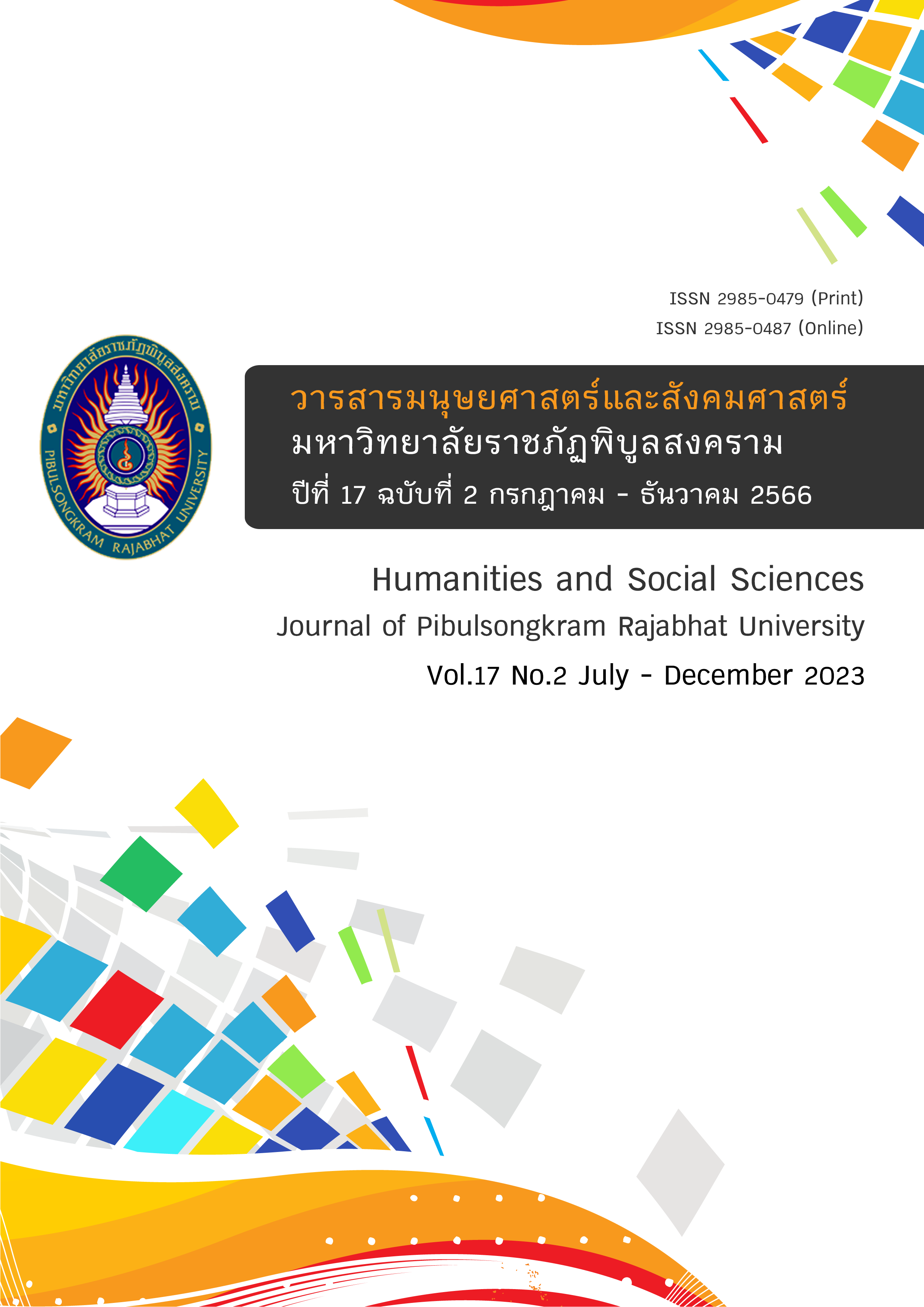The Adaptation of Shan Youth Through Education in Thailand
DOI:
https://doi.org/10.14456/psruhss.2023.40Keywords:
Adaptation, Shan youth, Education, Community cultural wealthAbstract
This article aims to present the results of the research entitled “The adaptation of Shan youth through education in Thailand.” The research objectives are to examine the factors and conditions of entry of second-generation Shan migrants who have enrolled into the Thai educational system, and their adaptation within this process. The study applied a qualitative research method, in which data was collected between May 2020 and January 2021 from four main case studies concerning those who are studying in/graduating from vocational and/or higher educational institutions in Chiang Mai. The study employed the concepts of Segmented Assimilation and Community Cultural Wealth. The main findings are that there are two key factors that have facilitated the entry of second-generation Shan migrants into education, in particular vocational and higher education. The first concerns the structural conditions of the educational system, which have gone through considerable revisions since the 1980s in order to improve access to education for disadvantaged children. The second factor concerns the individual level, in which case it was found that ‘spaces of hope’ are created throughout the educational process. However, the adaptation strategies that are taken up are flexible. Additionally, they apply various forms of capital which develop within the family and migrant community contexts. Analysis through an asset-based approach assists us to realize the multiple strengths of second-generation Shan migrants in their adaptation and persistence until graduation under various constraints in Thai society.
References
โกสุมภ์ สายจันทร์. (2554). บทสังเคราะห์ชุดโครงการวิจัยเรื่องสถานะและปัญหาของทายาทรุ่นที่ 2 ของผู้ย้ายถิ่นจากประเทศพม่า (รายงานการวิจัย). กรุงเทพฯ: สำนักงานกองทุนสนับสนุนการวิจัย.
ขวัญชีวัน บัวแดง. (2554ก). โครงการการปรับตัวทางสังคมและวัฒนธรรมของทายาทรุ่นที่ 2 ของผู้ย้ายถิ่นจากประเทศพม่า (รายงานการวิจัย). เชียงใหม่: คณะสังคมศาสตร์ มหาวิทยาลัยเชียงใหม่.
ขวัญชีวัน บัวแดง. (2554ข). ทายาทของแรงงานย้ายถิ่นจากพม่า การศึกษาและอัตลักษณ์ข้ามชาติ. ใน มูลนิธิเพื่อนไร้พรมแดน (บ.ก.), พลเมืองในโลกไร้พรมแดน (น. 124-155). กรุงเทพฯ: โครงการพัฒนาคุณภาพชีวิตแรงงานข้ามชาติและผู้มีปัญหาสถานะบุคคล และสำนักงานกองทุนสนับสนุนการเสริมสร้างสุขภาพ.
จารุวรรณ ไพศาลธรรม. (2559). แนวทางการจัดการศึกษาของบุตรหลานแรงงานข้ามชาติ (ไทใหญ่) ในเมืองเชียงใหม่. (วิทยานิพนธ์ปริญญามหาบัณฑิต). กรุงเทพฯ: มหาวิทยาลัยธรรมศาสตร์.
ชรินทร์ มั่งคั่ง และคณะ. (2558). การสร้างความเข้มแข็งทางอัตลักษณ์ชาติพันธุ์ของนักเรียนไทใหญ่ผ่านแหล่งเรียนรู้ชุมชนในพื้นที่ภาคเหนือของไทย (รายงานการวิจัย). เชียงใหม่: สถาบันวิจัยสังคม มหาวิทยาลัยเชียงใหม่.
นงเยาว์ เนาวรัตน์ (บ.ก.). (2559). ย้อนคิด 1 ทศวรรษ เด็กไทใหญ่ในโรงเรียน. เชียงใหม่: ศูนย์พหุวัฒนธรรมและนโยบายการศึกษา สถาบันวิจัยสังคม มหาวิทยาลัยเชียงใหม่.
นงเยาว์ เนาวรัตน์ และคณะ. (2555). ประชาสังคมและสิทธิทางการศึกษาสำหรับเด็กไร้รัฐ (รายงานการวิจัย). เชียงใหม่: คณะศึกษาศาสตร์ มหาวิทยาลัยเชียงใหม่.
นงเยาว์ เนาวรัตน์ และชญาณิศวร์ ยิ้มสวัสดิ์. (2560). สิทธิไร้ตัวตน: การศึกษาของเด็กข้ามชาติไทใหญ่ในโรงเรียนไทย จังหวัดเชียงใหม่ (รายงานการวิจัย). เชียงใหม่: คณะศึกษาศาสตร์ มหาวิทยาลัยเชียงใหม่.
บุบผา อนันต์สุชาติกุล. (2554). รูปแบบและการจัดการศึกษาสำหรับทายาทรุ่นที่ 2 ของผู้ย้ายถิ่นจากประเทศพม่า (รายงานผลการวิจัย). กรุงเทพฯ: สำนักงานกองทุนสนับสนุนการวิจัย.
วิจิตร ประพงษ์. (2563). ตลาดนี่นี้ใครครอง: การต่อรองพื้นที่สิทธิในตลาดของผู้ค้าเร่ไทใหญ่. ใน อานันท์ กาญจนพันธุ์ (บ.ก.), จุดตัดของเรื่อง ‘ต้องห้าม’ ในพื้นที่ความรู้ (น. 41- 99). เชียงใหม่: ภาควิชาสังคมวิทยาและมานุษยวิทยา คณะสังคมศาสตร์ มหาวิทยาลัยเชียงใหม่.
สมคิด แสงจันทร์. (2560). แรงปรารถนาและวัฒนธรรมวัยรุ่นของกลุ่มคนหนุ่มไต ในจังหวัดเชียงใหม่. (วิทยานิพนธ์ปริญญามหาบัณฑิต). เชียงใหม่: มหาวิทยาลัยเชียงใหม่.
สมชาย ปรีชาศิลปกุล. (2554). ความพลเมืองแบบลื่นไหลในยุคโลกาภิวัตน์ (Flexible Citizenship for a Global Society). ใน มูลนิธิเพื่อนไร้พรมแดน (บ.ก.), พลเมืองในโลกไร้พรมแดน (น. 40-69). กรุงเทพฯ: โครงการพัฒนาคุณภาพชีวิตแรงงานข้ามชาติและผู้มีปัญหาสถานะบุคคล และสำนักงานกองทุนสนับสนุนการสร้างเสริมสุขภาพ.
สำนักงานแรงงานจังหวัดเชียงใหม่. (2562). สถานการณ์และดัชนีชี้วัดภาวะแรงงานจังหวัดเชียงใหม่ ไตรมาส 1 ปี 2562 (เดือนมกราคม - มีนาคม). สืบค้น 3 พฤษภาคม 2563, จาก https://chiangmai.mol.go.th/wp-content/uploads/sites/18/2019/11/ sthaankaarnaerngngaan_cchanghwadechiiyngaihm_1-62.pdf.
อัมพร จิรัฐติกร. (2558). พื้นที่สาธารณะข้ามชาติ การเมืองเรื่องพื้นที่ของแรงงานอพยพไทใหญ่ในจังหวัดเชียงใหม่. เชียงใหม่: ศูนย์วิจัยและบริการวิชาการ คณะสังคมศาสตร์ มหาวิทยาลัยเชียงใหม่.
อานันท์ กาญจนพันธุ์ และชัยพงษ์ สำเนียง. (2557). แรงงานข้ามชาติ อัตลักษณ์และสิทธิความเป็นพลเมือง. เชียงใหม่: แผนงานเสริมสร้างนโยบายสาธารณะที่ดี และสถาบันศึกษานโยบายสาธารณะ มหาวิทยาลัยเชียงใหม่.
Crul, M., & Vermeulen, H. (2003). The Second Generation in Europe. International Migration Review, 37(4), 965- 986.
Moeller, M., & Bielfeldt, D. (2011). Shaping Perceptions: Integrating Community Cultural Wealth Theory into Teacher Education. Journal of Applied Learning in Higher Education, 3, 81-96.
Nawarat, N. (2018). Education Obstacles and Family Separation for Children of Migrant Workers in Thailand: A case from Chiang Mai. Asia Pacific Journal of Education, 38(4), 488-500, https://doi:10.1080/02188791.2018.1530191.
Portes A., & Rumbaut, R. (2005). Introduction: The Second Generation and the Children of Immigrants Longitudinal Study. Ethnic and Racial Studies, 28(6), 983-999.
Portes, A (Ed.). (1996). The New Second Generation. New York: Russell Sage Foundation.
Samuelson, C., & Litzler, E. (2016). Community Cultural Wealth: An Assets-Based Approach to Persistence of Engineering Students of Color. Journal of Engineering Education, 105(1), 93-117.
Waters, M., Tran, V., Kasinitz, P., & Mollenkopf, J. (2010). Segmented Assimilation Revisited: Types of Acculturation and Socioeconomic Mobility in Young Adulthood. Ethnic and Racial Studies, 33(7), 1168-1193.
Xie, Y., & Greenman, E. (2005). Segmented Assimilation Theory: A Reformulation and Empirical Test (Report 05-581 August 2005), USA: Population Studies Center, University of Michigan.
Yosso, T. (2005). Whose Culture has Capital? A Critical Race Theory Discussion of Community Cultural Wealth. Race Ethnicity and Education, 8(1), 69-91.
Downloads
Published
How to Cite
Issue
Section
License
Copyright (c) 2023 Humanities and Social Sciences Journal of Pibulsongkram Rajabhat University

This work is licensed under a Creative Commons Attribution-NonCommercial-NoDerivatives 4.0 International License.
Any articles or comments appearing in the Journal of Humanities and Social Sciences, Rajabhat Phibulsongkram University, are the intellectual property of the authors, and do not necessarily reflect the views of the editorial board. Published articles are copyrighted by the Journal of Humanities and Social Sciences, Rajabhat Phibulsongkram University.









